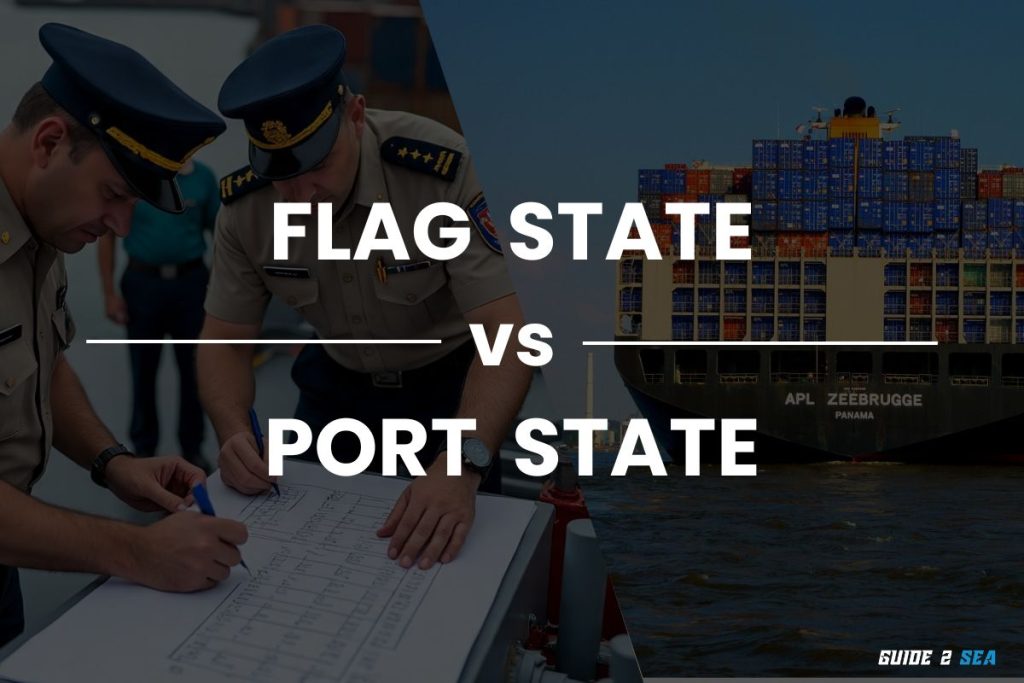The shipping industry connects countries, economies, and people around the world. Every day thousands of goods move across the seas and oceans. But with so many ships sailing worldwide, safety, environmental protection, and seafarers’ welfare are critical concerns. Who ensures these rules are followed? The answer lies in Flag State and Port State Control (PSC).
Understanding the difference between these two authorities is essential for anyone in shipping, logistics, maritime education, or maritime law. This article will explain the roles, responsibilities, and impact of flag state and port state control. It will help you to understand who regulates ships at sea.

What is a Flag State?
A flag state is the country where a ship is registered. Every ship must sail under the flag of a country, and this country becomes legally responsible for the ship. The flag state ensures that the ship complies with international maritime laws and maintains standards of safety, environment, and labor while at sea.
Responsibilities of a Flag State
Flag states have several critical responsibilities.
- Ship Registration—They maintain records of ships registered under their flag and issue official documents.
- Compliance with International Conventions—They ensure that ships meet standards set by conventions such as SOLAS, MARPOL, STCW, and MLC.
- Inspections and Audits—Flag states regularly inspect ships to verify safety equipment, crew certification, and overall seaworthiness.
- Certification—Flag states issue certificates for safety, pollution prevention, and crew qualifications.
- Investigation of Accidents—They investigate accidents involving ships under their flag to ensure compliance and improve safety measures.
Why Flag States Matter
The flag a ship flies determines which law applies onboard. Some countries offer “flags of convenience,” where ship owners benefit from easier registration and lower fees and strict labor regulations. While convenient, flags of convenience often face criticism for weaker enforcement of international safety and environmental rules.
Example:
- A ship registered in Norway must strictly comply with Norwegian laws and international conventions.
- A ship registered in Panama or Liberia, popular flags of convenience, must still follow international conventions, but inspections might be less frequent.
A flag state plays a primary role in ensuring safety, crew welfare, and environmental compliance at all times.
What is Port State Control (PSC)?
While the flag state is responsible for the ship at all times, Port State Control (PSC) allows countries to inspect foreign ships entering their ports. PSC is an inspection system designed to ensure that foreign vessels comply with international regulations.
A port state has three main goals.
- Protect human life at sea—ensuring that ships comply with safety regulations prevents accidents and loss of life.
- Prevent Marine Pollution—Checking compliance with MARPOL and environmental standards protects ocean and coastal areas.
- Ensure Compliance with International Conventions—PSC acts as a safety net in case the flag state fails to enforce regulations properly.
PSC inspections are particularly important for ships registered under flags of convenience, where flag state enforcement might be limited.
How PSC Works
Port authorities inspect foreign ships visiting their ports. During these inspections, PSC officers check
- Ship safety certificates under SOLAS
- Compliance with MARPOL for foreign environmental protection
- Crew qualifications under STCW
- Seafarers’ rights and welfare under MLC
- The condition of the ship’s hull, machinery, and equipment
If a ship fails an inspection, PSC officers can,
- Authorities detain the ship until it resolves the problems
- Issue fines or penalties
- Authorities deny the ship entry to the port until it ensures compliance
Port State Control acts as a backup enforcement system, ensuring that ships follow international rules even if the flag state does not fully enforce them.
Differences Between Flag state and PSC
| Feature | Flag State | Port State Control (PSC) |
|---|---|---|
| Authority | Country where a ship is registered | Country where the ship is visiting |
| Primary role | Enforces laws on the ship at all times | Inspects foreign ships to ensure compliance |
| Focus | Ship registration, crew certification, safety, environment | Safety, environment, crew welfare, certificates |
| Enforcements | Continuous oversight, audits, and inspections | Spot inspections during port visits; detention or fines |
| Legal accountability | Legally responsible for ship’s compliance | Support enforcement if the flag state fails. |
In a nutshell, flag states create regulations, and PSC ensures ships follow them in foreign ports. Both systems complement each other to maintain safety, environmental protection, and proper labor practices in shipping.
Importance of Flag State and Port State Control
- Global Safety—Ships travel across international waters, making it impossible for one country to monitor every vessel. The flag state ensures ships follow rules at all times, while PSC provides on-the-spot verification in ports.
- Environmental protection—From oil spills to air pollution, shipping can harm oceans and coastlines. Flag states require ships to follow MARPOL rules, and PSC authorities inspect ships to prevent violations.
- Crew welfare—Seafarers spend months at sea, making their safety and rights critical. Flag states enforce STCW and MLC standards, while PSC checks if these standards are upheld during port visits.
- Reducing non-compliant ships—ships that ignore safety or environmental rules can pose risks to people, cargo, and the environment. PSC inspections deter violations, especially for ships registered under flags of convenience.
Flag State and PSC in Action
Both the flag state and PSC work together in maritime-related activities. Let’s see how they act together.
Case 1: Safety checks to prevent accidents
A ship registered under a flag of convenience enters a European port. PSC officers find expired fire certificates and faulty lifeboats. The ship is detained until repairs are made. This helps to prevent a potential disaster at sea.
Case 2: Environmental Protection
A cargo ship enters an Asian port. PSC officers discover illegal oil discharges and fine the ship, and enforce corrective actions to prevent marine pollution
Case 3: Crew Welfare Enforcements
A cruise ship arrives at a Caribbean port. PSC officers check crew contracts, rest hours, and onboard accommodations. Violations are corrected, ensuring seafarers’ rights under MLC are protected.
These examples show how flag state responsibilities and PSC inspections work together to maintain safety, environmental protection, and crew welfare.
Conclusion
The maritime industry relies on both flag state and port state control to ensure safe, fair, and sustainable shipping.
- Flag state—Enforces rules onboard ships at all times, issues certificates, and ensures compliance with international conventions.
- Port State Control—Inspect foreign ships in ports to verify compliance and prevent unsafe, polluting, or non-compliant vessels from continuing their voyage.
Together, these systems create a strong global framework that protects lives, cargo, the environment, and seafarer welfare. For maritime students, professionals, and shipping companies, understanding these roles is important.
By following international rules, the maritime industry ensures safer seas, cleaner oceans, and fair treatment for all seafarers, supporting sustainable global trade.
Read Also


